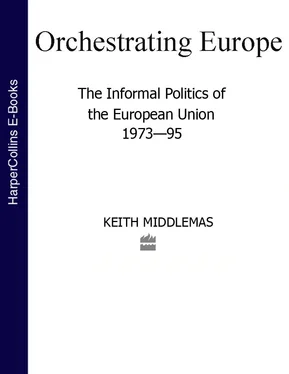EURATOM’s future was further enfeebled by the intervention of the United States. Back in 1946, the McMahon Act had tried to limit the spread of nuclear technology by classifying the fruits of US atomic research as secret. Paradoxically, by prohibiting collaboration of any kind, it had effectively prevented the Americans from exercising any control over developments that were already taking place. In his famous ‘atoms for peace’ speech to the United Nations in December 1953, Eisenhower had signalled a change in US policy which held out the prospect of the United States providing ‘fissionable material’ for projects designed to promote the peaceful use of nuclear energy. In February 1956, it offered 20 tons of enriched uranium to EURATOM at half the cost at which any European venture could hope to supply it. Aside from the noble aim of promoting peace (and deflecting attention from the fact that the ‘new look’ strategy could turn much of central and western Europe into a nuclear battlefield), the offer would displace UK competition and provide an outlet for the surplus of three US separator plants. It would also demonstrate American backing for a new supranational initiative. Finally, it would ensure that EURATOM would not build its own separation plant.
If EURATOM was not to build a separation plant (and right to the bitter end France tried to ensure that it should), then the French were determined to retain a separate national programme, keeping both peaceful and military options open. Moreover, France was only willing to surrender the sovereignty necessary to run a parallel operation, which in reality was not very much. The only limitation on its freedom of action was a four-year moratorium on testing. Parallel to these developments was a move in the OEEC for nuclear cooperation. Thus when EURATOM was formed, robbed already of most its substance and denuded of much supranational responsibility, one of its first acts was to pay the subscription of the six for joining the OEEC’s ‘Dragon’ scheme, to build an experimental reactor, an act which also absorbed much of its operational budget.
EURATOM had carried all the hopes of – and been the target of favourable propaganda by – the Action Committee for a United States of Europe, founded by Monnet in October 1955. It was only a ‘success’ in the sense that a treaty was signed at all. The other treaty signed in Rome in March 1957 was that establishing the European Economic Community (EEC). It was lucky to get onto the Messina agenda in the first place and, ironically, it was EURATOM that helped keep it there.
During the EDC negotiations, the Beyen Plan for the creation of a customs union had received varying degrees of support from five of the six governments. The Beyen Plan had at its core the creation of a customs union according to a rigid timetable over a period of 10–12 years. In order to accommodate countries in economic difficulties, the plan contained provisions for temporary escape clauses whose implementation and execution rested with the institutions of the EPC. There would also be an adjustment fund to assist countries with structural problems. Although the Beyen Plan failed because the French Assembly rejected the EDC treaty, the discussions about its merits had served to test the range of political opinion and to anticipate many of the technical problems. Firstly, the step-by-step approach to tariff cuts was condemned as too inflexible, making it more likely that countries would have difficulties in following the schedules. A less rigid programme, albeit with intermediate and final targets, was preferable. Secondly, the safeguard clauses were thoroughly disliked, by Germany and Belgium in particular. They argued that repeated backsliding followed by justification and appeals procedures would eventually destroy the community. Instead they urged far-reaching measures of policy coordination to prevent economies moving too far out of step, thereby removing the occasions for invoking these clauses. Thirdly, although the Dutch were heavily preoccupied with commodity trade, it became apparent to all that progress would be impossible unless capital and labour mobility were also dealt with. These were valuable insights, and all would eventually find their way into the Treaty of Rome. But there was one more factor in the summer of 1954: French politicians were implacably opposed to the idea of the EEC in whatever shape or form. 28
The Dutch government was inclined, rightly or wrongly, to ascribe trenchant French opposition to the complexion of the government then in power. Once the Mendès-France cabinet had fallen, the Dutch considered that the main obstacle to persisting with the initiative (or indeed to expanding it by incorporating agriculture) had been removed. Thus, when the idea of a ‘relaunch’ of European integration gathered momentum, the Dutch government made its support for the Benelux memorandum conditional upon the inclusion of a customs union in the list of demands presented at Messina. However Monnet, especially, was reluctant to risk a prompt rejection of a new European initiative because it introduced an immediate challenge to French protectionism. Curiously, the German government had had similar reservations and its delegation to Messina came armed with negative instructions on the customs union in order not to isolate the French. In the event, after a particularly indecisive meeting, an agreement was reached to establish study groups, under the overall direction of Henri Spaak, to investigate all the components of the Benelux memorandum. 29
Once the talks commenced, it became obvious that the French were primarily interested in atomic energy. However, the Germans, having been willing to back the French at a critical moment, entered the common market negotiations with conviction, as did the Belgians. Various pointers to the moment at which France decided to take the common market issue seriously have been offered by historians, but the most credible seems to be January 1956, when a new Socialist coalition led by Guy Mollet came to power. To dispel any tendency towards backsliding, from that moment the German delegation insisted that, whenever it was appropriate, there should be a ‘Junktim’ between the common market treaty and that for atomic energy.
The second revelation during this early phase of negotiations concerned the position of the United Kingdom. Surprised at having been invited at all, the UK had joined the initial talks without a prepared position, other than to express a loose preference for a free trade area over a customs union. Opinion within the cabinet soon afterwards veered towards a rejection of a closer European entanglement and when, in November 1955, Spaak announced that the talks had proceeded sufficiently to start preparing a final report, the UK delegation elected not to take any further part, but to judge the report when it appeared. In reality, the decision had already been taken to reject the common market option and, at the prompting of the Americans (and to avoid being saddled with any blame when the negotiations failed), the announcement was made the following month. But the common market negotiations did not collapse. 30
The ‘Spaak Report’ was approved by the ministers of the Six in May 1956 and negotiations proper were then able to start. But the French government’s conversion to the common market did not mean that it did not have to placate significant parliamentary opposition when the treaty came up for ratification. Thus a great deal of time and emotion was expended on what were ultimately peripheral items in the treaty. For example, France demanded that elements of its own expensive social legislation (equal pay for men and women, overtime pay for work beyond forty hours a week) be incorporated into the treaty to equalize competitive conditions. Once these demands had been conceded, the French delegation returned with a proposal for sharing some of its current colonial development costs in return for access to these countries’ markets. Even with such concessions in place, the government negotiated special provisions to allow France to commence lowering its tariff barriers later than the rest whilst still enjoying the benefits of market access elsewhere. None of these provisions added to the elegance of the treaty, but they all helped to condition acceptance by the French Assembly.
Читать дальше









![Brian Thompson - A Monkey Among Crocodiles - The Life, Loves and Lawsuits of Mrs Georgina Weldon – a disastrous Victorian [Text only]](/books/704922/brian-thompson-a-monkey-among-crocodiles-the-life-thumb.webp)


